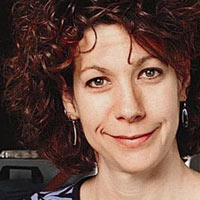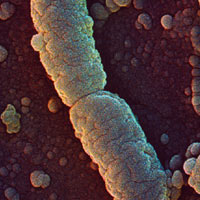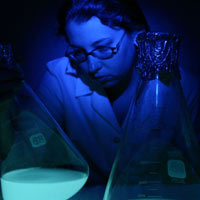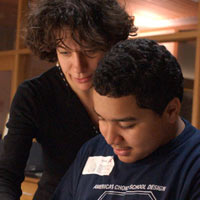


Despite what she refers to as her "bells and whistles," including a MacArthur award and membership in the National Academy of Sciences, Bonnie Bassler remains refreshingly modest. "What I never, ever want to do," she notes, "is take for granted how complicated Mother Nature is." 
Once you've heard Bassler describe the bacterial "sweaters" on your teeth each morning, you may step up your brushing. 
Extra pickles, but hold the E. coli... Our food is swarming with bacteria that generally don't harm us, but Bassler notes that in an era of industrialized agriculture, one infected cow can mean hundreds of dangerous burgers. 
The normally invisible process of bacterial reproduction can be glimpsed in a scanning electron micrograph. (Magnification is x17,500 when image is roughly 2 x 2.8 inches.) 
Bassler and her students helped turn a harmless, bioluminescent bacterium into a star of scientific research—a model organism holding lessons about how all bacteria communicate. 
Through outreach efforts such as mentoring middle school students in the Princeton area, Bassler wants "to help people understand that biology is charming and lovely and not scary." |
Princeton geneticist and Howard Hughes Medical Institute Investigator Bonnie Bassler helped lead a revolution in the way scientists think about bacteria. Her lab's work on quorum sensing—essentially how bacteria "talk" with one another and act as groups—has spawned a flurry of medical research and may one day bring us a new class of drugs. In this interview, Bassler may change the way you think about what many people consider just "germs." LIVING WITH BACTERIAQ: If I wanted to find lots of bacteria, where should I look? Bonnie Bassler: You can find bacteria everywhere. They're invisible to us. I've never seen a bacterium, except under a microscope. They're so small, we don't see them, but they are everywhere. Your body is covered with bacteria. You have 1010 bacterial cells in your gut. You only have 109 human cells making up your whole body. So there are 10 times more bacterial cells in you, or on you, than human cells. By weight, you are more human than bacteria, because your cells are bigger, but by numbers, it's not even close. Now, most people think this is all bad. And don't get me wrong, bacteria can be bad. But they're also really, really good. All these bacteria that coat our skin and live in our intestines, they fend off bad bacteria. They protect us. And you can't even digest your food without the bacteria that are in your gut. They have enzymes and proteins that allow you to metabolize foods you eat. Q: It seems like we only notice the bacteria on our teeth. Bassler: Of course. You get up in the morning, and your teeth are covered with those little "sweaters." Well, those sweaters are what we call a bacterial biofilm. Every morning, there are over 600 species of bacteria on your teeth. And they are arranged in a beautiful (I think [laughs]) architected community. And it turns out that only the first couple of those 600 species have the proteins that allow them to stick to your teeth. They're not the ones that can digest the enamel and give you a cavity. They need the next guy, and the next guy. And every morning, you have the same structure on your teeth, even though you got rid of it before. Q: So we're all swarming with bacteria, and that's generally okay. Bassler: Most bacteria aren't bad. We breathe and eat and ingest gobs of bacteria every single moment of our lives. Our food is covered in bacteria. And you're breathing in bacteria all the time, and you mostly don't get sick. That's because your immune system evolved specifically to see bacteria and to do surveillance: to tell the bad guys from the good guys, and to get rid of the bad ones. And it's rare that it doesn't work. But those are the cases you think about. Q: But some of the bad ones—the pathogens—today seem unstoppable. Bassler: It's true. There are these few bacteria that have us on our hands and knees. They're so virulent and so resistant to the antibiotics that we have today. But what's made these bacteria incredibly harmful is the way we live in the 21st century. It used to be, if somebody got sick—some unfortunate person—he or she just croaked. But now you can be on a plane before you even know you're sick, and you can be around the world infecting people that afternoon. Right? It used to be you just died on the boat ride over. We are living in this 100-year window where, because of technology and travel, we are encountering bacteria we've never encountered before. But if one were alive 100 years from now, the bacteria that you would hear about would have completely different names, because we would have evolved a little bit, and the bacteria would have evolved a little bit. Think about all kinds of infectious diseases, like mumps, or measles, or chicken pox. When a virgin population encountered those pathogens, it ravaged the population, and now they're childhood diseases, and eventually they won't even be that. That's our relationship with bacteria, going through time. POWER IN NUMBERSQ: Can you very broadly describe your research? Bassler: In my lab, we are always thinking about how cells, bacterial cells, can talk to each other and then organize themselves into enormous groups that function in unison. Q: So, step-by-step, how does this communication among bacteria work? Bassler: The process is called quorum sensing. It's a fancy name for bacteria communicating with chemical "words" and working in groups. Bacteria are these single-celled organisms. They're one cell, they have no nucleus, they just have one piece of DNA inside them, and so they're the simplest forms of life. And the way bacteria reproduce is they just eat and grow, and then they pinch themselves in half and become two. So they're not having sex; they're just dividing in half and making exact replicas of themselves. As the bacteria are growing, each one is releasing a small amount of chemicals that we call auto-inducers, but you can think of them like hormones. At first there's just a little bit of this molecule, and it floats away. But then, with more cells growing, there's more of this molecule. So you see, the amount of the chemical auto-inducer in the environment is proportional to the number of cells present; the more cells, the more molecule. And when the auto-inducer molecule is at a significant concentration, the bacteria start grabbing onto this molecule. They have receptors—they're like antennae that are on their membranes—that grab onto this molecule. And that is the signal that tells them there are a lot of other cells in the vicinity, so they should all change their behavior. So what they do is change their gene expression. They turn on genes that are good when they're in a community but that do them no good when they're acting alone. Q: Can you give an example? Bassler: The best example of this is in virulence—when bacteria make us sick. When you ingest a few bacteria, the worst thing the bacteria can do for themselves is to start releasing toxins, the things that really make you sick, because those are huge red flags to your immune system. So what the bacteria do instead is they wait. And they start dividing and making and releasing these small quorum-sensing molecules. And then, when they finally recognize that there are enough of them around, now if everybody releases toxins together, it's going to be a fabulous and effective strategy to make the host sick. Instead of one guy acting against you, now they have 108 or 109 acting against you simultaneously. Essentially, what quorum sensing allows bacteria to do is to be multicellular. It's incorrect to think of bacteria as these asocial, single cells. They are individual cells, but they act in communities, exactly the way cells in your body work together and the way groups of people do. And they get more bang for their buck if everybody helps out. THE "RIDICULOUS" BACTERIUM THAT STARTED IT ALLQ: Tell me about the glowing bacteria you work with. Bassler: It's a harmless marine bacterium named Vibrio harveyi, after E. Newton Harvey, who discovered it off the coast of Boston. It's just a generic bacterium from the ocean, but it has this amazing trait: it makes bioluminescence. It makes light in a similar way that fireflies make light. And this glowing, and hundreds of other traits in Vibrio harveyi, are controlled by quorum sensing. Q: Glowing in the dark seems pretty magical. How do the bacteria do it? Bassler: They make enzymes that produce photons of beautiful blue light. We think it's special, but it's not that special in the ocean; almost everything in the ocean either makes its own light or uses someone else's. In the ocean, you don't have to go very deep before it's pitch-black. And so using and manipulating processes with light is a huge deal. Q: So did you initially start studying this bacterium to understand lightmaking? Bassler: No. Everybody always thought I wanted to understand bioluminescence. This was when Mike Silverman and I were working together. [Editor's note: From 1990 to 1994, Bassler was a Postdoctoral Fellow and then Research Scientist in geneticist Michael Silverman's lab at the The Agouron Institute in La Jolla, California.] We never, at some level, cared about bioluminescence. We always wanted to understand how cells talk. We were using the light as a very convenient, visual readout of the cells' talking together with these chemical molecules. [Harvard biologist] Woody Hastings, almost 40 years ago now, made this remarkable observation that when the Vibrio harveyi bacterium was dilute—when there were only a few cells around—it didn't make light. But when they grew to a particular cell number, all the cells turned on light together. Mike and I wanted to understand, how does a bacterium recognize when it's alone versus when it's in a community? So there were two reasons to study this ridiculous Vibrio harveyi bacterium. One, these luminous bacteria were the only ones we knew that could recognize these two different situations—alone versus together. And second, what was great about bioluminescence as an indicator that cells were talking, and still is great, is you can see it! You just turn the lights off in the room, and it glows in the dark. Q: So it helps you that they glow? Bassler: It helps a lot. In my lab, we are primarily geneticists. And what geneticists do to understand certain traits and processes is try to "break" them by making mutations in DNA. We want to understand cell-to-cell communication, and we know that the indicator of when the bacteria are talking is that they glow. So we try to make mutations so that the bacteria don't make light when they are together, or do make light when they are on their own. Then we can go back and figure out what's wrong with them. FROM COCKAMAMIE IDEA TO TEXTBOOK SCIENCEQ: And now it seems that other bacteria can do this "talking," right? Bassler: What's become clear in the last decade is that all bacteria talk to each other. Bacteria are chattering like crazy. Once quorum sensing genes were found in bacteria that people think are important—like pathogens—more and more people started entering the field. Now hundreds and hundreds of labs work on quorum sensing. We now realize that the way we all used to think of and study these bacteria—as these asocial, reclusive, shy organisms—is completely wrong. This isn't how they're living out in the wild. And so there's been this sort of paradigm shift. It turns out we just completely missed the boat, myself included, until about a decade ago. I think my lab played a big part in making the world see that bacteria have these complicated vocabularies that are made up of many different molecules, and that this is very much like how cells inside the human body interact. Q: Of all the different discoveries your lab has made, which one are you the most proud of? Bassler: That changes as time goes by, because I'm very maternal about those kids in my lab. I mean, science is done by children—by 20-to-30-year-olds. These kids are responsible for changing how we think about the world. But I guess the thing that my lab is most known for is showing that bacteria can communicate between species. We found this universal molecule and the gene that makes it. We know what it is, we know how it works, and we now know how the bacteria, at least at first blush, talk between species. So I'm really proud that these kids worked on that cockamamie idea until it became textbook science. Q: Is there an analogy between how bacteria "talk" and how we use language? Bassler: You can think of the molecules that bacteria make as words, or languages. And we're starting to think that bacteria are multilingual. So they have a language that's, say, English; they have their own molecule that they talk to each other with. And another species of bacteria, they're the French, and they have their own molecule. But then there's a language, and you can think of it like Esperanto, or the trade language of bacteria. This Esperanto molecule everybody understands, and it makes the bacteria multilingual. One species still can't understand the private languages of other species. But they can all understand the trade language. Q: Forgive me for asking this, but why is it such a surprise that bacteria can talk to each other? Bassler: It shouldn't be a surprise that bacteria can talk to each other. "Uh, why did it take you so long?" [laughs] It's simply because we had it wrong—"we" meaning everybody in science. But of course, in retrospect, when we think about it, it shouldn't have been a surprise. For a long time, we recognized the importance of chemical communication between our cells, and how groups of cells know "self" from "other," and that chemistry is running the show inside higher organisms. Well, where did that come from? Of course, bacteria invented that. Bacteria were on Earth for billions of years before higher organisms evolved. FUTURE DREAMS AND GORGONZOLAQ: Now for the inevitable, "what-practical-applications-will-come-of-this?" question. Can we interfere with their communication in ways that will help us? Bassler: The question is, can we control quorum sensing? Hopefully, the answer is yes. We understand that bacteria control virulence as a group, as a function of quorum sensing. We know that different species of bacteria can trick each other and garble up each other's languages. We humans are not so dumb, we should be able to do that, too. And so there is this tremendous move in the quorum-sensing field to try to develop a whole new kind of antibiotics based on anti-quorum sensing strategies. And bacteria also do all kinds of good things for us—we use bacteria to make all kinds of human products. So we would also like to make molecules that enhance quorum sensing, so that we can exploit the good bacteria and get them to do things that we want them to do even better. Q: Like? Bassler: Like making insulin and other drugs that we mine from bacteria. Another idea is to try to control commensal bacteria—those 1010 bacteria that are in you, and on you, and all over you. They also have quorum sensing. We might be able to make them better at fending off predators or invaders. Maybe we can make pro-biotics that help you not get sick in the first place. There are all these ideas for manipulating quorum sensing that have very practical human consequences. It's an amazing dream. Q: Do you have a particular dream? What do you want to do in the future? Bassler: I want to make an anti-quorum sensing drug. I want to actually, in my lifetime, help people. I want the science to be more than "we're learning these fundamental principles, blah, blah, blah, blah, blah." I think we are doing that, but I want to do something really practical that impacts people's lives fundamentally. So that's one thing. The other thing is, I just want the fun that I'm having with this group [her lab] to continue, and to keep getting the right people in that group so that they can find new things about how cells communicate. A lot of what I want to do is more of the same, because I enjoy every minute of every one of my days, and so why mess with that? Q: One last question: Some people think that if you eat a lot of blue cheese or yogurt, you can prep your body to fight off bad bacteria. True or false? Bassler: I think the answer is false. The data suggests that your personal microflora is incredibly hard to perturb, which is good because you hardly ever get sick. There is no data that when you take these kinds of health-food treatments that you actually change by one iota the bacterial consortium that's there. Now, that doesn't mean you won't be able to do that in the future. But it has to be taken out of the realm of the health-food store and into the realm of science. Q: So no extra helpings of Gorgonzola?
Bassler: Yogurt's still good, it's filled with calcium. And blue cheese
tastes good. [laughs] Now that we've talked about blue cheese, I'm hungry. Can
we get some lunch?
|
“It's incorrect to think of bacteria as these asocial, single cells.” “It turns out we just completely missed the boat, myself included, until about a decade ago.” “The question is, can we control quorum sensing?” |
|||||||||
|
Interview conducted on October 19, 2006 by Carla Denly, producer of the NOVA scienceNOW segment "Profile: Bonnie Bassler," and edited by Susan K. Lewis, editor of NOVA online |
|||||||||||
|
© | Created December 2006 |
|||||||||||
